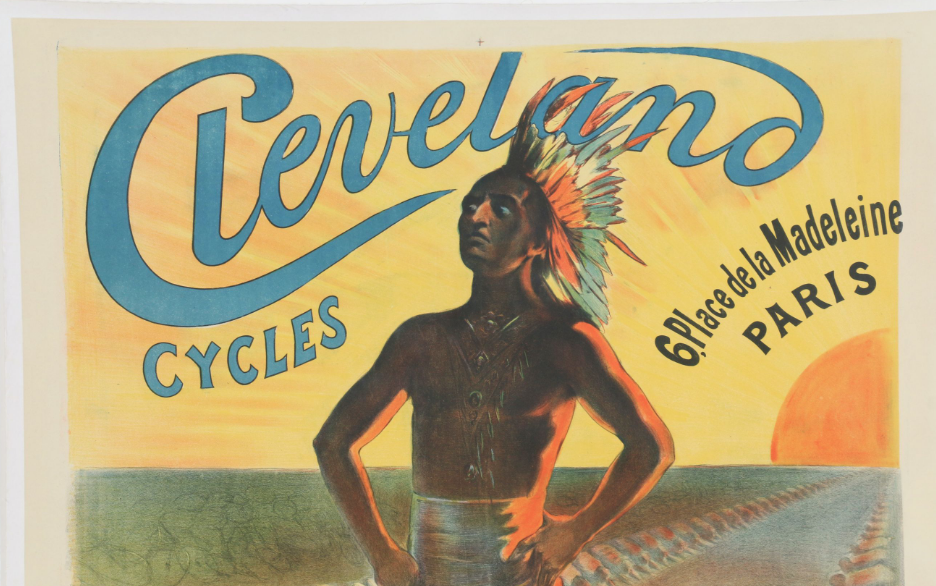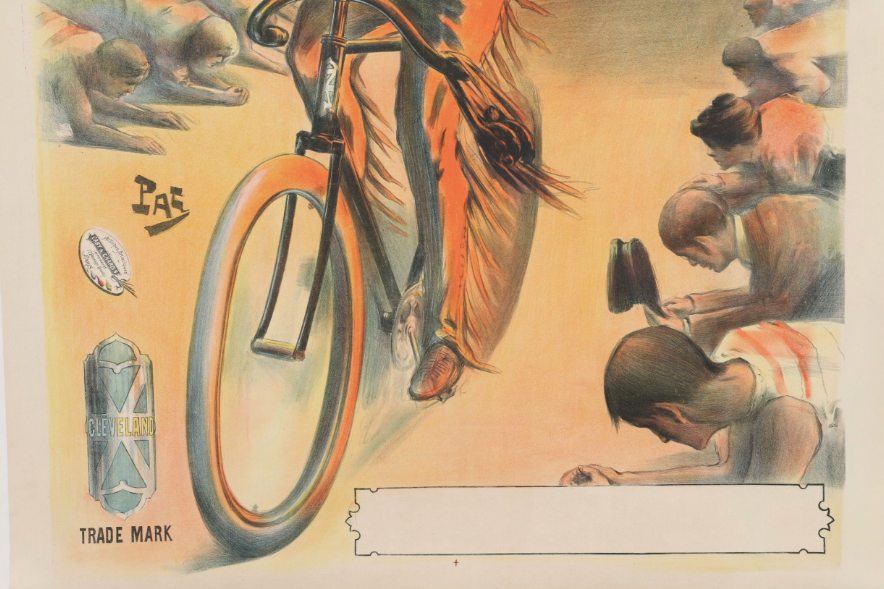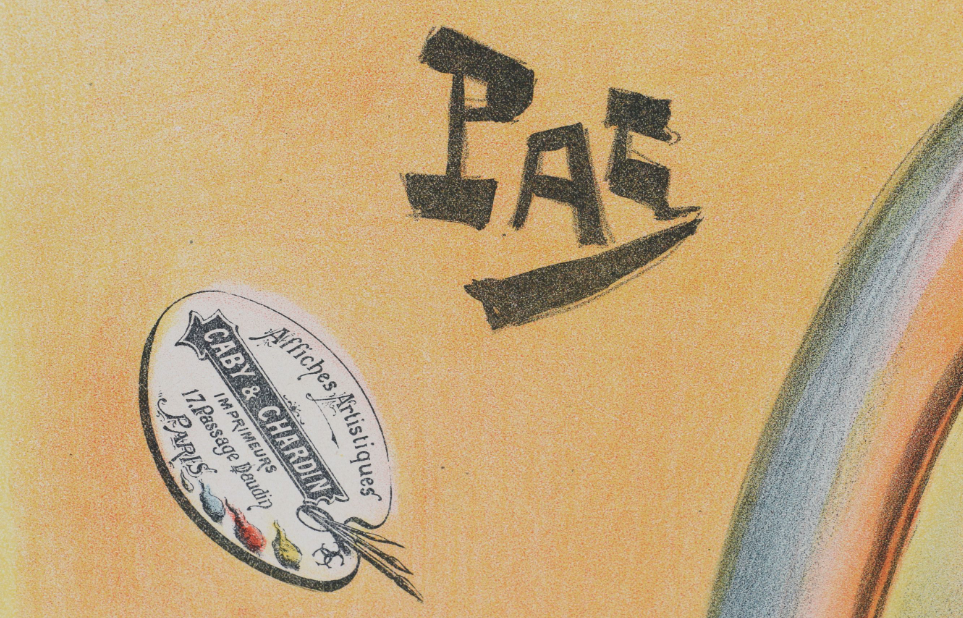A “dramatic” 19th century cycling poster and the story behind it
As cycling becomes more and more common in these environmentally-aware times, the hobby of collecting bicycling memorabilia has also become an increasingly popular pastime. And a dramatic cycling advertising poster from the end of the 19th century, part of the December 7 Miller & Miller Auctions sale of the John McKenty CCM Collection, is an important addition to any collection.
The poster features a Cleveland Cycles bicycle, presented in a highly dramatic setting, as a Native American proudly rides the vehicle through a crowd of adoring fans. And while the image certainly seems quaint, at the least, today, in 1898 it was not only a dramatic advertising and artistic statement, it was also a very progressive take on a historic stereotype.
Cleveland Cycles were built by the H.A. Lozier company in Toledo, Ohio – a company with a significant Canadian connection – but this poster was created for the French market. The impressive 1898 artwork, a stone lithograph, was painted by French advertising artist Jean Pal de Paleologue (signed with his typical “Pal” signature). The poster was executed at an important moment in the history of bicycling, and in the history of the Lozier company. It was created near the end of the worldwide “bicycle boom,” which cycling memorabilia expert Lorne Shields says began around 1890, and which ended near the end of the century, with the growing popularity of the automobile.
The Poster
The art work captured the imagination of the intended European audience, depicting what was then an iconic North American image: a native Indian in full headdress, riding regally on a wooden Cleveland Cycle, flanked by bowing admirers. Shields notes that the rider is shown as “a human being who is upright, proud and in total control.” He adds that there are clever messages built into the work – the rider has his hands on his hips; this hands-free stance demonstrates that this is “a good quality bike.”
In spite of the historic nature of the key figure, the poster emphasizes the modern innovation inherent in the bicycle. The rider is coming out of the sun. “He’s as modern as can be,” says Shields, adding that the iconic image of a Native American astride a horse has been replaced by something more modern. And the reaction of the crowd? “People are bowing down to this modern, technologically advanced machine coming from across the ocean…. Everybody is in awe.” In fact, they are so impressed with the new Cleveland technology that they have abandoned their own outdated bikes en masse – as shown in the fields behind the awe-struck “worshippers”.
Shields says that this particular poster is “very collectible… not commonly found.” He adds that posters by artists such as Jean Pal de Paleologue were collectible even at the time they were first issued, seen then – as now – as highly desirable works of art. This Cleveland Cycles poster, which measures 64” by 48” is described as French, linen-backed with fine professional restoration to strengthen minor edge and border tears, along with a section of paper loss to the upper right border. Airbrush to border.
The Company
The Lozier Manufacturing Company made Cleveland bicycles in its plant in Toledo. At the time, it was one of the leading bicycle manufacturers in the world. And in the 1890s, the company opened a large branch plant in Toronto. In 1897 the Toronto Evening Star announced that the Toronto factory employed “2500 skilled operatives.” Only a year after the poster was produced in France, in 1899, the Canadian Lozier operation merged with four other companies to become the highly successful bicycle and sports equipment company, CCM.
In the 1890s, The Lozier Manufacturing Company opened a large branch plant in Toronto. Source.
The Cycling Boom
University of Toronto historian Anita Rush has written that the bicycle boom of the ‘Gay Nineties’ “ranged between 1895 and 1899.” In an article published online, she added, “It was a striking phenomenon because of the amount of publicity it generated and because it arose in the middle of the depression that plagued the decade. The beginning was marked with high society taking up the wheel… An air of glamour attached itself to cycling and popular literature began to devote much attention to the new craze.”
The boom in interest meant a boom in manufacturing – Lozier was just one of over 300 American bicycle companies that were in business at the height of the craze.
An advertisement promoting the opening of the Toronto factory. Source.
Today, the “craze” is focused on collectibles like this dramatic French Cleveland Cycles poster, which Shields describes as “a good, biddable auction item.” Miller & Miller Auctions’ estimated value of the poster is $4,000 to $6,000. That might be a bargain; more than ten years ago, an appraiser on the iconic Antiques Road Show valued an identical poster at that same price – but in American dollars.
Story by Paul Knowles
Item Estimate: $4000 - 6000
Lot Number: 66
Auction Details: Advertising & Historic Objects, December 7th, 2019. 9 am.
Live Auction Location: 59 Webster St. New Hamburg, Ontario. N3A 1W8
Did you enjoy this article? Feel free to share it using the links below:






